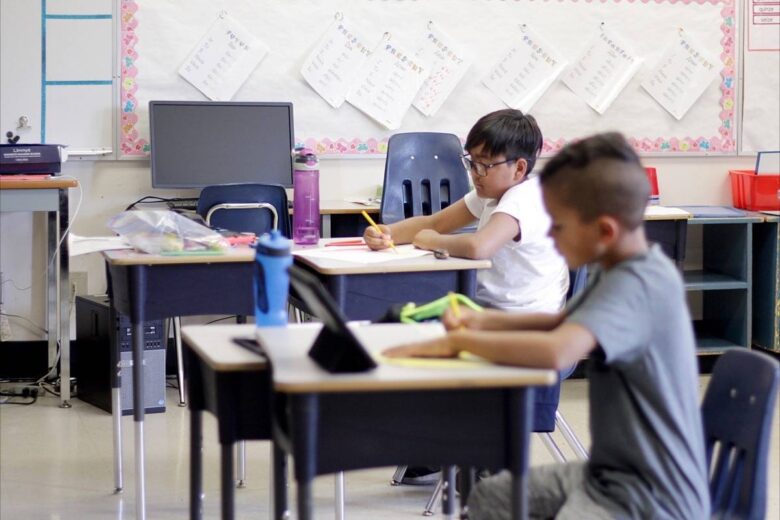The reopening of schools around the world amid the coronavirus pandemic has been the subject of on-going debate. In early spring, schools across the UK shutdown to slow the spread of the virus—with some exceptions—essential workers’ children and vulnerable pupils were still attending school during the lockdown.
As weeks turned into months, health care professionals and educators began to express their concern over school closures doing more harm than good. According to an open letter published by the Royal College of Paediatrics and Child Health (RCPCH), long-term closures risk “scarring the life chances of a generation of young people.” Time away from the classroom is damaging to children’s cognitive and academic development, especially for underprivileged children who lack the basic resources needed to support their learning. At the same time, there have been substantial reports of increased abuse and neglect, malnutrition, and mental health problems, which further supports children’s’ return to school.
Consequently, for many children, the benefits of being back in school outweigh the low risk of contracting COVID-19. With re-opening inevitable, David Kalmanovitch, a child psychologist in London, discusses four ways the Department of Education will help protect children in the classroom.
Facemasks Not Recommended in Schools

Source: californiahealthline.org
Countries around the world are adopting their own list of safety guidelines as schools set to reopen in the fall. The UK government’s website, which involves comprehensive strategies for resuming classes, discourages the use of face masks or face coverings in educational settings. The recommendation reads: “Face coverings (or any form of the medical mask were instructed to be used for specific clinical reasons) should not be worn in any circumstance by those who may not be able to handle them as directed (for example, young children, or those with special educational needs or disabilities) as it may inadvertently increase the risk of transmission.” While facemasks are an effective preventative measure for adults, children may lack the self-discipline needed to wear them for hours without constantly wanting to touch their face or readjust. Additionally, the Prime Minister’s official spokesman has revealed that teachers will not have to wear PPE unless providing care for a child who exhibits COVID-19 symptoms.
Kalmanovitch notes that this measure is still under review and could be subject to change in the future. “There are several other nations that choose not to enforce face coverings in schools,” he explains. For instance, in Germany, pupils are asked to wear masks in hallways or bathrooms but can remove them once safely seated at their distantly spaced desk. Similarly, Austria has decided to abandon the use of facemasks in classrooms altogether as they observed minor transmission within schools.
Enhanced Cleanliness and Hand Washing Procedures

Source: pexels.com
To promote the well being of students and staff, the government suggests ensuring students with COVID-19 symptoms refrain from school, introducing more frequent hand washing, promoting good respiratory hygiene, and sanitizing frequently touched surfaces. “While it may seem obvious, regular hand washing is essential if we want to prevent ourselves from contracting the virus,” says Kalmanovitch. Schools must encourage pupils to clean their hands as soon as they arrive at school, when they return from recess, after changing rooms, and before and after eating. For example, multiple hand sanitizer stations will act as a reminder to motivate children and teachers to clean their hands often.
Meanwhile, UK schools are also asked to follow a ‘catch it, bin it, kill it’ approach, where individuals are asked to sneeze or cough into a tissue, dispose of it, and wash their hands immediately. As a result, institutions must be equipped with enough tissues and garbage bins to make sure pupils follow this routine. “Incorporating frequent hand washing and good hygiene into the school’s culture will make it easier for younger children and those with special needs to understand and follow such guidelines,” says Kalmanovitch. Finally, schools will undoubtedly follow strict cleaning schedules that involve regular sanitation of common areas and frequently touched surfaces using high-quality detergents and other cleaning products.
Social Distancing

Source: northdeltareporter.com
Some pupils may experience feelings of anxiety about their return to school after being told to social distance and avoid spending time with friends for months on end. For many children, the wave of restrictions, constant news stories, or their personal experience with COVID-19, has made the outside world seem like a dangerous place. For example, six-year-old, Jeremiah Israel-James in New York, is not ready to go back to school and see his friends, CNN reports. Jeremiah is just one of many children exhibiting concern over returning to school and contracting coronavirus. “When a child is anxious, they lack the concentration needed to do well in school,” says Kalmanovitch. As such, some students returning to school may be easily distractible, appear disengaged, or become emotionally reactive to certain situations. Kalmanovitch suggests parents have an honest conversation with their children about the changes they can expect to see when they return to school to help ease their fears.
Ample research indicates that COVID-19 is spread primarily through close contact when one person inhales small droplets produced by an infected person. UK schools will do everything in their power to ensure proper social distancing measures are implemented to protect children and staff. The UK government recommends dividing children into smaller groups called ‘bubbles’ and maintaining social distancing within each ‘bubble.’ When implementing social distancing, schools will need to take into consideration each child’s ability to distance, the layout of the school, and the feasibility of keeping distinct groups separate while offering a broad curriculum. Some UK institutions might take pointers from other schools currently operating in other nations. For example, some schools in the Netherlands have installed plastic shields around students’ desks, while educators in Denmark are taking pupils outside and writing with chalk on the playground as opposed to a blackboard.
Testing and Tracing

Source: vietnaminsider.vn
Staff members and parents should be aware of the infection response protocol and be willing to follow these guidelines. Firstly, educators and pupils are encouraged to stay home if they are experiencing any coronavirus symptoms, or be sent home immediately if symptoms are detected at school. Anyone who is displaying signs of infection should apply to get tested. Subsequently, parents should be able to provide a list of anyone their child has been in close contact with in the event they test positive. Contact tracing is important to be able to stop the spread of the virus and avoid nationwide lockdowns. Finally, people who have tested positive and those they have come in contact with must self-isolate to prevent further transmission. “Some countries are implementing additional preventative measures in hopes that it won’t come to this,” says Kalmanovitch. In Shanghai, after three months of lockdown, students and staff are required to enter the school building via a thermal scanner. Although it feels more like entering a hospital than school, the extra safety precautions mean students may be less likely to contract COVID-19.
Since children so rarely develop severe symptoms, experts have cautioned that re-opening schools may pose a greater risk to teachers and family members than to the students themselves. Fortunately, schools around the world are implementing preventative measures to help protect children and the wider community. Kalmanovitch urges parents to start talking to their children and preparing them for back to school to ensure they get the most out of their education without being worried about catching COVID-19.

